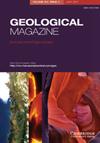The physical volcanology of large-scale effusive and explosive silicic eruptions in southeastern Saurashtra, Deccan Traps
IF 2
3区 地球科学
Q3 GEOSCIENCES, MULTIDISCIPLINARY
引用次数: 0
Abstract
Abstract Silicic magmatism, minor overall in the ∼65.5 Ma Deccan Traps continental flood basalt (CFB) province of India, was widespread in the Saurashtra region. We describe the physical volcanology of silicic volcanics and dykes exposed around Rajula–Savarkundla–Gariyadhar–Talaja towns in southeastern Saurashtra. The silicic volcanics conformably overlie basaltic lavas, suggesting rapid subaerial volcanism, and the sequence shows gentle tectonic dips (∼15°) towards the Arabian Sea. Rhyolites and dacites with preserved thicknesses of tens of metres show intense internal rheomorphic deformation, and a dacite shows a well-formed basal autobreccia. The rheomorphic rhyolites, and vitrophyres which often underlie them, lack vitroclasts (glass shards and pumice clasts). They have very similar mineral assemblages (quartz and alkali feldspar phenocrysts, and crystal cargoes dominated by calcic plagioclase and clinopyroxene or orthopyroxene, sometimes with olivine). The rheomorphic units are thus flood rhyolite and dacite lavas, apparently common in the northern-northwestern Deccan, and the vitrophyres their basal chilled parts. Tuffs (including crystal-vitric Plinian fallout ash) and eutaxitic ignimbrites formed from pyroclastic density currents; one tuff contains extraordinary numbers of lithophysae. Ridges of rhyolitic tuff breccias with pervasive secondary silicification and ferruginization represent pyroclastic eruptive fissures. The area thus records large-scale effusive and explosive silicic eruptions. Mafic and silicic dykes intrude the basaltic lavas and rarely the silicic volcanics. Mafic enclaves in several silicic dykes and some volcanics indicate magma mingling as a common phenomenon. The seaward-dipping volcanic units define a regional-scale flexure comparable to coastal flexures in CFB provinces worldwide, suggesting extensive block-faulting of this classical volcanic rifted margin.德干陷阱Saurashtra东南部大规模喷出和爆炸性硅化物喷发的物理火山学
摘要硅质岩浆作用,在印度约65.5 Ma的德干圈闭大陆洪流玄武岩(CFB)省总体较小,在索拉什特拉地区广泛存在。我们描述了Saurashtra东南部Rajula–Savarkundla–Gariyadhar–Talaja镇周围暴露的硅化火山岩和岩脉的物理火山学。硅化火山岩顺应性地覆盖在玄武岩熔岩上,表明快速的陆上火山活动,该序列显示出朝向阿拉伯海的平缓构造倾角(~15°)。保存厚度数十米的Rhyolite和英安岩显示出强烈的内部流变变形,英安岩则显示出形成良好的基底自角砾岩。流变型流纹岩和通常位于其下方的玻璃体缺乏玻璃碎屑(玻璃碎片和浮石碎屑)。它们具有非常相似的矿物组合(石英和碱长石斑晶,以及以钙质斜长石和单斜辉石或斜方辉石为主的晶体货物,有时带有橄榄石)。因此,流变单元是泛滥的流纹岩和英安岩熔岩,在德干西北部北部很常见,而玻璃体是其基底冷却部分。由火山碎屑密度流形成的凝灰岩(包括结晶镜质的上新世沉降灰)和共轴熔结凝灰岩;一种凝灰岩含有数量惊人的石藻。普遍存在次生硅化和铁矿化的流纹质凝灰岩角砾岩山脊代表了火山碎屑喷发裂缝。因此,该地区记录了大规模的喷出和爆炸性的硅化物喷发。镁铁质和硅化岩脉侵入玄武岩熔岩,很少侵入硅化火山岩。几个硅化岩脉和一些火山岩中的黑手党包体表明岩浆混合是一种常见现象。向海倾斜的火山单元定义了一个区域规模的弯曲,与世界各地CFB省的海岸弯曲相当,表明这一经典火山裂谷边缘存在广泛的块体断裂。
本文章由计算机程序翻译,如有差异,请以英文原文为准。
求助全文
约1分钟内获得全文
求助全文
来源期刊

Geological Magazine
地学-地球科学综合
CiteScore
4.70
自引率
0.00%
发文量
111
审稿时长
3 months
期刊介绍:
Geological Magazine, established in 1864, is one of the oldest and best-known periodicals in earth sciences. It publishes original scientific papers covering the complete spectrum of geological topics, with high quality illustrations. Its worldwide circulation and high production values, combined with Rapid Communications and Book Review sections keep the journal at the forefront of the field.
This journal is included in the Cambridge Journals open access initiative, Cambridge Open Option.
 求助内容:
求助内容: 应助结果提醒方式:
应助结果提醒方式:


